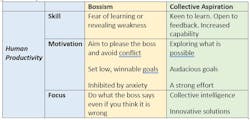Is ‘Bossism’ Getting in the Way of Your Leadership?
Most leaders still believe that the way to maximize productivity is to set demanding goals and enforce compliance.
The universal challenge for managers, indeed for whole organizations, is how to maximize results with the resources they have. Too often, this brings out an old-school, bossy persona from people leaders. In the short run, employees do what they are told, but over time motivation, innovation and a sense of agency decrease. These leaders end up with less-capable teams who are too dependent on them and trap them in the weeds. It also becomes harder for leadership to attract and hang on to the good talent in our highly fluid and competitive labor market where company culture is so transparent on social media.
Fortunately, management may be making progress beyond its punitive legacy as leaders discover better ways to achieve superior performance. Largely, this comes down to a focus on encouraging collective effort and building capability instead of demanding results and compliance to an authority figure. You see this with agile project management and with the objective and key results goal-setting framework (OKRs). You see it in highly successful organizations, and you see it from inspirational leaders and their psychologically safe teams.
This shift to a leadership style and process that promotes aspiration versus traditional “do as I say” bossism is hard for many people leaders because of how we have been shaped by our parents, teachers and organizational culture. If we are honest, the question for many of us remains “will this positivity actually produce better results?”
Personally, I grew up in an era when parents and teachers were stern and to be feared. There are still plenty of us late boomers among the executive ranks of corporate America. Come to think of it, I actually was caned at prep school and my brother and I were spanked at home when our school report cards arrived. This was all quite common from a generation shaped by war’s brutality and its military command-and-control philosophy.
The punishment didn’t help our academic performance at all. In fact, it produced the opposite; increased fear of authority, generalized anxiety, poor self-esteem and decreased productivity.
While business leaders in the U.S. are now two generations apart from the post-war boomers, their cultural inheritance still dominates. Most leaders still believe that the way to maximize productivity is to set demanding goals and enforce compliance through the use of organizational carrots and sticks. This power- and fear-based style is the norm for all but the most progressive organizations.
But bossism must be an inherited cultural legacy rather than a rational choice because it doesn’t stand up to the known equation for maximizing human productivity. If you remove the external factors (i.e., the relative advantages of product, brand, technology, scale) you maximize human productivity by having skilled and motivated people focused on the right priorities. This is the Northstar; attract and develop exceptional talent, get them on the right projects and get them jazzed.
When we look through this lens, we see the relative effects of traditional bossism versus promoting collective aspiration on the required elements for human productivity.
If you are interested in trying out a more productive leadership style, here are some practical steps you can explore:
1. Reduce the time you spend on one-on-ones and re-invest that time in team meetings
2. Work with the team to review everchanging priorities so they can focus on what’s most important.
3. Ask the team what they think they can accomplish from one check-in period to the next
4. Facilitate rather than direct an effort
5. Coach and guide if/when team members are struggling
6. Use a task board to visualize priorities, progress and achievements
7. Reward aspiration and effort over results
8. Check in to support the effort, not check up to blame
9. Listen more than speak. A good rule of thumb for team leaders is speak no more than others.
10. Take a breath, or sleep on it when you feel yourself getting frustrated.
11. Make it feel safe and inclusive for everyone. Encourage contributions from the less-dominant.
This model of leadership doesn’t abandon accountability or lower the bar. Quite the opposite, it achieves more by shifting the team’s motivation from lackluster obedience to the boss to a strong collective effort toward ambitious goals.
In order to maximize productivity, we need leaders to engage with their teams, to discuss and clarify priorities and to facilitate aspiration rather than be bossy. Everyone benefits from this shift. Employee motivation, development and retention go up. The boss is liberated to focus on higher-value activities, and generalized anxiety goes down. In summary, a happier workforce achieves superior results.
Based in the San Francisco Bay area, Chris Morgan is founding principal of Morgan Alexander, a consulting firm that coaches senior management teams to lead winning organizations, and co-founder of ListenTool. He is one of a few executive coaches with more than 20 years of experience, having started with The Alexander Corporation. Morgan’s clients are primarily CXO engagements with Fortune 500 companies, and high-tech startups in the San Francisco Bay area.





